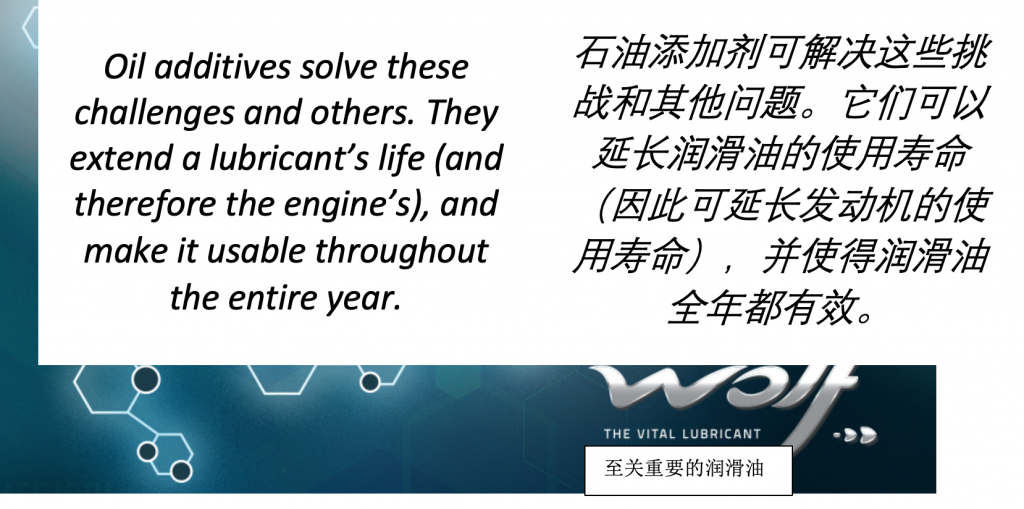2: 润滑油基础知识:石油添加剂快速指南
MOTOR OIL HAS BECOME A HIGHLY COMPLEX PRODUCT. IT USES THE EXACT RIGHT COMBINATION OF ADDITIVES TO MAKE A SPECIFIC ENGINE TYPE RUN BETTER AND LONGER. UPDATE YOURSELF ON THE BASICS OF OIL ADDITIVES IN JUST A FEW MINUTES.
机油已经变成一种非常复杂的产品。通过采用精确组合的添加剂,汽油可以让特定发动机类型更好、更长时间地运行。只需几分钟让你了解石油添加剂基础知识。
In our previous article in our series on the basics of lubricants, we introduced you to the concept of base oils. A quick memory refresh:
我们在之前关于润滑油基础知识的系列文章中,向您介绍了基础油的概念。快速记忆刷新:
The foundation of every lubricant is base oil, which comes in two types: Mineral base oils and synthetic base oils. Base oil determines the viscosity – or “thickness” – of a lubricant. When looking at the overall composition of a lubricant, base oils make up 70-90% of a lubricant.
每种润滑剂的基层都是基础油,分为两种类型:矿物基础油以及合成基础油。基础油确定润滑油的粘度,即“稠密度”。从润滑油的整体成分来看,基础油占到润滑油的70-90%。
The remaining 10-30% consists of additives, in various combinations. These are chemical components that enhance the oil’s performance. Did you know oil additives are also called dopes? In this second article in the series, we’ll dive deeper into the topic of additives.
剩下10-30%的润滑油包括各种组合的添加剂。这些化学成分可提高润滑油的性能。您是否知道石油添加剂又叫铅油?本文是本系列中的第二篇,我们将深入了解添加剂的含义。
Why do we need oil additives?
为何需要添加剂?
In theory, you could think base oil would be enough to lubricate an engine. But the reality is different. To name just a few problems that would occur:
理论上您可能认为基础油已经足以作为发动机的润滑油。但事实却不一样。仅举几例会出现的问题:
- Oil oxidates. Many materials show a chemical reaction when exposed to oxygen for a certain amount of time. This is called oxidation, and rust (on iron) is a well-known example. Oil can oxidate too, especially at higher temperatures such as inside an engine.
- 油氧化。许多材料在氧气中暴露一段时间后会产生化学反应。这种反应叫做氧化,众所周知的例子就是生锈(在铁上)。油也会氧化,特别是在发动机内部等高温环境下。
- Because an engine collects soot, dust, and other particles, the oil would quickly get contaminated and break down or leak out.
- 由于发动机会集聚烟灰、灰尘和其他颗粒,因此油很快就会受到污染,然后分解或泄漏。
- A base oil’s viscosity fluctuates with temperature. Just like cooking with olive oil, base oil is thicker when it’s cold and runnier when it’s warm. As a result, base oil might have the right thickness in summer but not in winter — or the other way around.
- 基础油的粘度随温度而变。就像做饭用的橄榄油一样,在寒冷的环境中,基础油会更稠密,在温暖的环境中会更易于流动。其结果是,夏季时基础油的稠密度可能正好,但在冬季则不然,即恰好相反。

At the same time, additives address the fact that engines have become much more complex over the last 10-15 years. Under the pressure to make engines smaller and better performing at the same time, engine manufacturers have introduced many innovative features that demand more sophisticated lubricants. This is where oil additives come in.
同时,石油添加剂也解决了过去10-15年中,发动机变得更加复杂的情况。面对让发动机更小和性能更佳的双重挑战,发动机制造商引入了许多需要更加复杂润滑油的创新功能。这就让石油添加剂有了用武之地。
The checklist of oil additives
石油添加剂清单
At Wolf, we have been developing new and innovative lubricants since more than 60 years in close collaboration with the major additive suppliers. Oil additives need to possess specific properties to be fit for commercial use. Here are a few important ones.
Wolf与主要添加剂供应商密切合作已经超过60年,一直在开发新型和创新型润滑油。石油添加剂需要具有特定性能以适用商业用途。以下是一些重要的性能。
Additives
- must be fully and fast soluble in base oil
- generally must be insoluble in water, if not they would be washed out when the oil is exposed to water
- may not chemically react with other additives or water
- must be easily manageable and contain an acceptable safety risk
添加剂
- 必须在基础油中完全和快速溶解。
- 通常必须不溶于水,否则当基础油接触到水时,添加剂会被冲掉
- 不会与其他添加剂或水发生化学反应
- 必须易于管理,包含可接受的安全风险
As a side note, for efficiency reasons, oil manufacturers prefer multifunctional additives. These have multiple benefits built-in in a single additive. What are the beneficial characteristics of these additives? We’ll give you the 5 most common additives.
另请注意,因为效益,石油制造商更喜欢的是多功能添加剂。多功能添加剂在一种添加剂中就包含多种益处。这些添加剂的有益特性如何?我们将为您介绍五种最常见的添加剂。
5 additives you should know
您应该了解的五种添加剂
Let’s take a look at five common oil additives.
我们来看看五种常见添加剂。
- Antioxidants
This is probably the most used type of additive. Just like food, for example, oil oxidates, meaning it decomposes under the influence of oxygen from the air at higher temperatures. Antioxidants prevent this. The most commonly used antioxidant is zinc dithiophosphates (or ZDTP).
1.抗氧化剂
这可能是最常用的添加剂。就像食物一样,油也会氧化,即在高温下,由于空气中氧气的影响,油会分解。抗氧化剂可以防止氧化。最常用的抗氧化剂是二硫代磷酸锌(ZDTP)。
- Detergents
A working engine produces several ‘waste products’. Three examples are:
- deposits formed at high temperature
- acids that arise from combustion (especially when using sulphurous lubricants)
- and dust from outside the engine.
2.净化剂
发动机的运行会产生几种“废渣”。其中的三个例子是:
- 高温下形成的沉淀
- 燃烧产生的酸(特别是在使用硫润滑剂时)
- 以及发动机外部的灰尘。
Detergent additives ‘clean’ an engine of these and possibly other materials. They contain metal elements such as calcium (Ca), magnesium (Mg) or barium (Ba), which explains why they, in their turn, produce ashes. The amount of ash is expressed by the so-called ash-number that legally cannot exceed certain values.
净化剂可“清洁”发动机的这些“废渣”和可能产生的其他材料。净化剂含有钙(Ca)、镁(Mg)或钡(Ba)等金属元素,这就解释了它们为什么会产生灰分。灰分的量由所谓的灰分数表示,灰分数不得超过特定的值。
- Dispersing additives
There are specific engine deposits that detergent additives cannot handle. Often called sludge is formed at low temperature and during ‘start-stop conditions’. If not dealt with, these deposits would congeal and obstruct oil filters and pipes. Luckily, we have dispersing additives. They keep the deposits and other elements in suspension, so they do not congeal. This is the reason that oil becomes darker when used. Naturally, there is a limit to how many particles an oil can contain. That’s why motor oil gets changed every now and then: The oil has gotten too saturated with sludge and other elements. Follow your car’s manufacturer recommendations for your oil change interval — as you can’t draw any conclusions from the oil color as seen on the dipstick.
3.分散剂
有些发动机沉淀是净化剂无法处理的。这些沉淀通常称为油泥,在低温和“启停状态”下形成。如果不处理,这些沉淀就会凝结并阻塞油过滤器和管路。幸运的是,我们有分散剂。分散剂会让沉淀和其他物质保持悬浮状态,从而不会凝结。这就让油在使用时变得更暗。当然,油中颗粒的含量有限制。这就导致机油偶尔会发生变化:因为有油泥和其他物质,因此油过于饱和。换油间隔按照您的汽车制造商的建议来执行,因为您无法从油尺上的颜色看出任何结果。
- VI improvers
The viscosity index or VI of a lubricant is an important characteristic. It used to be that engines needed ‘winter oil’ and ‘summer oil’, each with a different VI. Basically, VI improvers turn a lubricant into an all-season oil.
4.粘度指数改良剂
润滑油的粘度指数(VI)是一个重要的指标。过去,发动机需要有“冬季油”和“夏季油”,每种油都有不同的粘度指数。粘度指数改良剂基本上可让润滑油全年使用。
The most important VI improvers are: Polyalkylmetacrylats (PMA), alkene copolymers and polyisobutylenes. They are polymers with high molecular weight, meaning they’re viscous or thick (just like honey). That’s why they are barely sold in their pure form, but rather as a solution in oil.
最重要的粘度指数改良剂是:聚烷基甲基丙烯酸酯(PMA)、烯烃共聚物和聚异丁烯。它们是具有高分子量的聚合物,即为粘稠状,或很稠密(就像蜂蜜一样)。这就是为什么这些聚合物几乎都并非以纯聚合物的形式出售,而是作为一种石油解决方案来出售。
One disadvantage of these polymers is that shearing, which occurs in parts of the engine that move at high speed, can decrease their effectivity to control viscosity. We call this shear viscosity loss. Naturally, VI improvers with a low tendency to lose their viscosity are preferred.
这些聚合物有一个缺点,即高速运动的发动机部件所发生的剪切会降低其控制粘度的效率。我们称之为剪切粘度损失。当然,首选的是具有低粘度损失趋向的粘度指数改良剂。
As a bonus, VI improving additives can also have dispersing characteristics or can function as pour point depressants.
粘度指数改良剂的另一个好处就是其也具有分散特性,或可用作降凝剂。
- Pour point depressants (PPD’s)
Lubricants must flow evenly, even when it’s cold. But without additives, at lower temperatures oils would show crystallized paraffin particles — think of how olive oil becomes cloudy when it’s cold.
PPD’s avoid that these particles lump together and thus hinder the flowing of the oil. Just as VI improvers, PPDs are polymers.
5.降凝剂(PPD)
润滑剂必须均匀流动,即便很冷的环境中也应如此。但如果没有添加剂,油在低温下会出现蜡晶颗粒 ,如同橄榄油在寒冷的环境中会变得浑浊。
降凝剂可避免颗粒结块并阻碍油的流动。降凝剂和粘度指数改良剂一样,也是聚合物。
And that’s just the beginning
这仅仅是起步知识
There you have them: Five of the most important additives to be aware of.
But there are many more. Anti-wear additives, anti-corrosion additives and friction modifiers are just a few. We’ll come to those on another occasion.
现在你就掌握了:需要了解的五种最重要的添加剂。
但还有更多的添加剂。仅举几例:抗磨添加剂、抗腐蚀添加剂和摩擦改性剂等。我们会在以后的文章中继续讨论。
In short:
- The foundation of every lubricant is base oil, while the remaining 10-30% consists of additives.
- Additives solve oxidation, production of soot particles, and viscosity problems.
- 5 important additives are: antioxidants, detergents, dispersing additives, VI improvers, and pour point depressants.
总结:
- 每种润滑油的基层都是基础油,剩余的10-30%为添加剂。
- 添加剂可解决氧化、烟灰颗粒生成和粘度问题。
- 五种重要的添加剂是:抗氧化剂、净化剂、分散剂、粘度指数改良剂和降凝剂。


